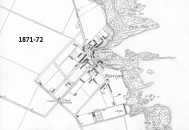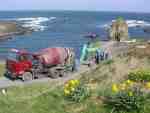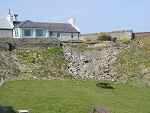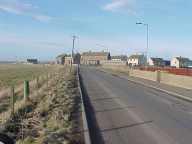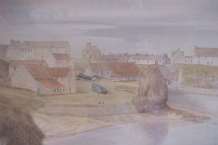|
STAXIGOE
The name comes from two Norse words - "GJA"
or "GOE" meaning an inlet, and "STAKKR" meaning a
rock or stack, hence "Staxigoe", the inlet of the stack. At
the end of the 18th and the beginning of the 19th century, a few
unscrupulous landlords began evicting tenants from land which had been
theirs since the times of the clan system. Sheep had arrived in the
Highlands, and the "Highland Clearances" began. Men were sent
to war out of loyalty to their chief, and those who returned found their
homes and crofts burned and their families scattered to the four corners
of the earth. Those who were left - women, children, and the old people
- had to walk the 100 miles or more from the hills and straths of
Sutherland to the bleak and barren coasts to try to find settlements and
a means of living. The growth in population of Staxigoe, Wick and many
hamlets and villages along the coast resulted in the birth of herring
fishing. Inexperienced men went out into the ferocious German Ocean (now
the North Sea) in small boats powered only by sail and oar - many were
never seen again.
The Pole
The pole was erected in the middle of the nineteenth century as
barometer used by the fishermen to determine the weather conditions at
sea. The houses were built of the sturdy Caithness flagstone and
their unique red roofs were tiled with the red tilesd brought in on Dutch
boats as ballast. The tiles were off-loaded at Staxigoe and replaced
with cargo. The harbour houses were demolished in the late 1940's
and most of the families were rehoused in the new council built houses
which now form part of the village. The Noss head lighthouse was
built by Stevenson in 1849 and for 150 years its light has guided shipping
safely past the treacherous waters around Noss Head.
The Girnals
Built in the early 19th century the girnals were used as storage
warehouses. Crofters and farmers in the surrounding area brought
their grain to Willie Oman's Mill at Papigoe, where it was ground, bagged
and then stored in the girnal at Staxigoe harbour to a wait shipment to
many parts of the world. Along the coast, between Staxigoe and Noss
Head are the old slate quarries which provided work (very hard work) for
some of the villagers.
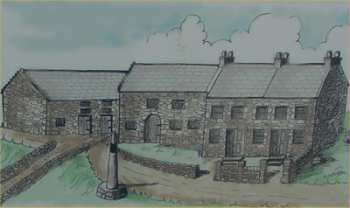
Men and boys walked to and from the quarry and slate was among the large
variety of goods which were transported to many parts of Britain and
further afield.
|
31 March 2005
A Beautiful spring Day At Staxigoe

 The
weather was breezy and the temperature low. But the air was
certainly bracing and if you kept on the move well worth a walk round
Staxigoe. The daffodils are once again out in the gardens and out
along the farm road. The waves were breaking and crashing into the
rocks. The new house where once one of the old barns stood is
beginning to look established. The last of the three old barns still
stands but who knows for how much longer.
The famous Pole used by sailors making for Staxigoe looks fresh and
someone has kindly added a small barometer. The
weather was breezy and the temperature low. But the air was
certainly bracing and if you kept on the move well worth a walk round
Staxigoe. The daffodils are once again out in the gardens and out
along the farm road. The waves were breaking and crashing into the
rocks. The new house where once one of the old barns stood is
beginning to look established. The last of the three old barns still
stands but who knows for how much longer.
The famous Pole used by sailors making for Staxigoe looks fresh and
someone has kindly added a small barometer.
7 March 04
Sunday Football At Staxigoe - Boys Organise Their Own Mini Five-a-side
Competition
 Boys from Staxigoe,
Wick and Pulteneytown organised their own five-a-side competition for
Sunday afternoon and certainly got stuck in with a few goals on the pitch
at the site of the old Staxigoe School Boys from Staxigoe,
Wick and Pulteneytown organised their own five-a-side competition for
Sunday afternoon and certainly got stuck in with a few goals on the pitch
at the site of the old Staxigoe School
30 November 03
Staxigoe - New House
Where Old Barns Used To Be
 The
new house at Staxigoe has a magnificent view over the harbour out to sea
and along the coast. Speculation still abounds as to whether the
third remaining old barn will follow the others to make way for a further
housing development. On the one hand many will regret the
passing of such well-known local nineteenth century buildings. With
little of old Staxigoe left to see the old barns were in need of a lot of
repair work just o retain them as they were and with no one coming forward
to maintain them or suggest a new use the final one may follow the other
two into history. The
new house at Staxigoe has a magnificent view over the harbour out to sea
and along the coast. Speculation still abounds as to whether the
third remaining old barn will follow the others to make way for a further
housing development. On the one hand many will regret the
passing of such well-known local nineteenth century buildings. With
little of old Staxigoe left to see the old barns were in need of a lot of
repair work just o retain them as they were and with no one coming forward
to maintain them or suggest a new use the final one may follow the other
two into history.
|
|
The Fishing Industry
The fishing industry flourished and became the livelihood of almost
every family along the Caithness coast. Staxigoe became the first
port in Europe to 'salt the herring'. The fish were packed in barrels of
salt imported from the Baltic, then shipped to the Baltic countries,
England, Ireland and as far as the Americas to help feed the slave
population. Herring, known to the fishermen as "the silver darlings"
and the smoked variety - "kippers", was , for many years, the staple diet
of the Scottish people.
At one time, Staxigoe was the largest, "herring station" in Europe and the
industry created work for the gutters, coopers, basket and sail-makers,
carpenters and not least, the fishermen themselves. In the early
days, as many as 50 boats could anchor in Staxigoe harbour.
Gradually, boats got bigger and became mechanised by steam, and a safe
haven was needed for the bigger boats, somewhere along the rocky windswept
coast. the government provided money for just such a project, but
after a bit of political manoeuvering, Wick was chosen as the port in
which the new harbour would be built.
The Watters Well
The main Herring Curing Station in Staxigoe was housed in the harbour
basin, and was owned by William Watters. In 1868 the well was built
and presented to the village by William Watters to provide a supply of
clean water for the villages. Many people ran pipes from the well,
and with the aid of pumps were able to bring the water into their own
homes. the original well was situated approximately 500 metres from
the harbour and the stonework from that well now stands behind the village
hall. |
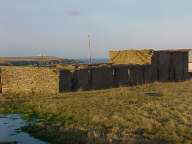
Click here for nine
pictures of old Staxigoe

Elsay
Broch near Staxigoe

Noss
Farm April 2002 |

More Old Staxigoe

Staxigoe
School
1946-47
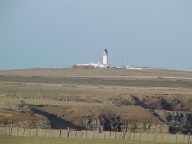
From Noss Farm to Noss Lighthouse |

